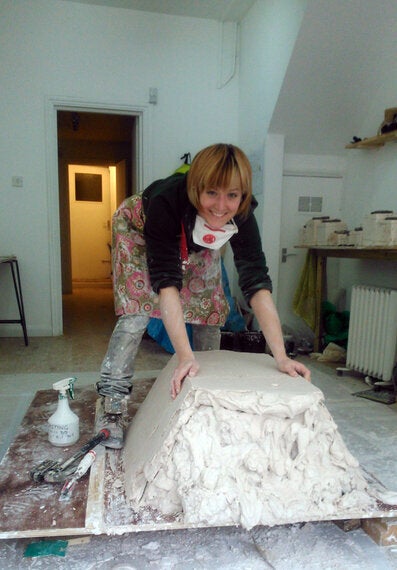It's often forgotten that the process of creating a work of art is normally a private affair. The artists's studio has assumed a somewhat mythical status where creativity, both mental and physical, results in raw materials being fashioned into something refined well away from the public gaze.
Not so with Eva Masterman. For the past three weeks, the 28-year-old sculptor has turned London's William Benington Gallery into her own studio with all the accoutrements required for creating high-spec ceramic sculptures - bags of industrial raw materials, assorted moulds, tools and equipment. And with lots of slushy material around, it's a very messy business.
The residency, culminating in the forthcoming exhibition showing the fruits of her labour, is entitled Studio and has positively encouraged people to gain a rare glimpse into the creative process. Masterman has developed a kind of work in progress installation in which the viewer is able to witness the relationship between the objects and the processes used to create them.

In the picture above, Masterman is about to crack open a plaster mould she has constructed, to reveal half of a plaster hexagon that will be fashioned into a ceramic sculpture. A graduate in Fine Art at Kingston University, she is currently taking a Masters degree at the Royal College of Art in ceramics. She has acquired new skills here including various forming techniques, slip casting and plaster-based sledging.
Sledging is an old technique used for plaster cornicing in which a profile is cut out from a substance such as zinc to which runners such as you'd find on a sledge - hence the name - are attached. These are then run in a straight line in the manner of one of those bobsleigh competitors pushing the sled at the start of a run, in so doing building up plaster which is liquid to begin with before gradually increasing in consistency until it goes hard.
It requires an almost manic application that has drawn many an onlooker to the gallery windows.
"I've been mould making of various kinds for about seven years now," Masterman tells me as she straddles the mould ready to chisel it open. "I really love the mess of it as well, the moments when you open something up and get this object in the middle of it, the revealing qualities of it, the transformative nature of the materials. I really enjoy it."
In previous residencies and group exhibitions, from as far afield as Germany and China, Masterman has focused on using what she sees as the correct materials and processes that best translate the ideas behind her work.
For example, her interest in movement and space saw her documenting walks in the countryside and translating the emotion of the experience into a solid work of art. She would use clay because it linked back to the landscape by way of the earth on which she had trodden.
Since then, she has experimented with concrete and other industrial materials such as plaster, and has placed them next to high-craft elements concerned with ceramics and so on. She has also amalgamated into her work new technology such as 3-D printing and modern processes such as laser cutting, thus lending her work a contemporary feel.

Both sledging and slip casting, in which a liquid clay body slip is poured into plaster moulds and allowed top form a layer or cast, generates a certain amount of excess material which Masterman then uses to create sculptures many of which, as in the picture above, will be on sale at the exhibition. In so doing, she explores ideas of repetition and perfection versus the flawed one-off.
It also means that the exact nature of the final exhibits only becomes apparent as her work progresses.
"I hope what I'll achieve at the end of this show is to see all the happy accidents that happen along it and the interesting moments that happen which you just don't see at the other end of it. With the traditional ceramic methods especially, you're constantly trying to get rid of the process whereas for me it's all about the journey of making and how that informs the final piece."
Eva Masterman Studio exhibition runs April 28 - May 19 at the William Benington Gallery, 20 Arlington Way, London EC1 1UY.
The images are used with the permission of the gallery.